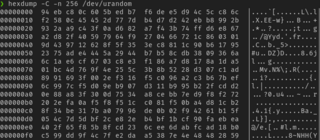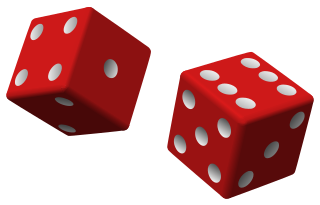A pseudorandom sequence of numbers is one that appears to be statistically random, despite having been produced by a completely deterministic and repeatable process. Simply put, the problem is that many of the sources of randomness available to humans rely on physical processes not readily available to computer programs.
A pseudorandom number generator (PRNG), also known as a deterministic random bit generator (DRBG), is an algorithm for generating a sequence of numbers whose properties approximate the properties of sequences of random numbers. The PRNG-generated sequence is not truly random, because it is completely determined by an initial value, called the PRNG's seed. Although sequences that are closer to truly random can be generated using hardware random number generators, pseudorandom number generators are important in practice for their speed in number generation and their reproducibility.

A linear congruential generator (LCG) is an algorithm that yields a sequence of pseudo-randomized numbers calculated with a discontinuous piecewise linear equation. The method represents one of the oldest and best-known pseudorandom number generator algorithms. The theory behind them is relatively easy to understand, and they are easily implemented and fast, especially on computer hardware which can provide modular arithmetic by storage-bit truncation.
The Mersenne Twister is a general-purpose pseudorandom number generator (PRNG) developed in 1997 by Makoto Matsumoto and Takuji Nishimura. Its name derives from the choice of a Mersenne prime as its period length.

In computing, a hardware random number generator (HRNG), true random number generator (TRNG), non-deterministic random bit generator (NRBG), or physical random number generator is a device that generates random numbers from a physical process capable of producing entropy, unlike the pseudorandom number generator that utilizes a deterministic algorithm and non-physical nondeterministic random bit generators that do not include hardware dedicated to generation of entropy.
A cryptographically secure pseudorandom number generator (CSPRNG) or cryptographic pseudorandom number generator (CPRNG) is a pseudorandom number generator (PRNG) with properties that make it suitable for use in cryptography. It is also loosely known as a cryptographic random number generator (CRNG).

In Unix-like operating systems, /dev/random and /dev/urandom are special files that serve as cryptographically secure pseudorandom number generators (CSPRNGs). They allow access to a CSPRNG that is seeded with entropy from environmental noise, collected from device drivers and other sources. /dev/random typically blocked if there was less entropy available than requested; more recently it usually blocks at startup until sufficient entropy has been gathered, then unblocks permanently. The /dev/urandom device typically was never a blocking device, even if the pseudorandom number generator seed was not fully initialized with entropy since boot. Not all operating systems implement the same methods for /dev/random and /dev/urandom.
Fowler–Noll–Vo is a non-cryptographic hash function created by Glenn Fowler, Landon Curt Noll, and Kiem-Phong Vo.
The security of cryptographic systems depends on some secret data that is known to authorized persons but unknown and unpredictable to others. To achieve this unpredictability, some randomization is typically employed. Modern cryptographic protocols often require frequent generation of random quantities. Cryptographic attacks that subvert or exploit weaknesses in this process are known as random number generator attacks.
A random password generator is a software program or hardware device that takes input from a random or pseudo-random number generator and automatically generates a password. Random passwords can be generated manually, using simple sources of randomness such as dice or coins, or they can be generated using a computer.
A random seed is a number used to initialize a pseudorandom number generator.

Random number generation is a process by which, often by means of a random number generator (RNG), a sequence of numbers or symbols that cannot be reasonably predicted better than by random chance is generated. This means that the particular outcome sequence will contain some patterns detectable in hindsight but impossible to foresee. True random number generators can be hardware random-number generators (HRNGs), wherein each generation is a function of the current value of a physical environment's attribute that is constantly changing in a manner that is practically impossible to model. This would be in contrast to so-called "random number generations" done by pseudorandom number generators (PRNGs), which generate numbers that only look random but are in fact pre-determined—these generations can be reproduced simply by knowing the state of the PRNG.
CryptGenRandom is a deprecated cryptographically secure pseudorandom number generator function that is included in Microsoft CryptoAPI. In Win32 programs, Microsoft recommends its use anywhere random number generation is needed. A 2007 paper from Hebrew University suggested security problems in the Windows 2000 implementation of CryptGenRandom. Microsoft later acknowledged that the same problems exist in Windows XP, but not in Vista. Microsoft released a fix for the bug with Windows XP Service Pack 3 in mid-2008.
A randomness test, in data evaluation, is a test used to analyze the distribution of a set of data to see whether it can be described as random (patternless). In stochastic modeling, as in some computer simulations, the hoped-for randomness of potential input data can be verified, by a formal test for randomness, to show that the data are valid for use in simulation runs. In some cases, data reveals an obvious non-random pattern, as with so-called "runs in the data". If a selected set of data fails the tests, then parameters can be changed or other randomized data can be used which does pass the tests for randomness.
In computing, entropy is the randomness collected by an operating system or application for use in cryptography or other uses that require random data. This randomness is often collected from hardware sources, either pre-existing ones such as mouse movements or specially provided randomness generators. A lack of entropy can have a negative impact on performance and security.

A lava lamp is a decorative lamp, invented in 1963 by British entrepreneur Edward Craven Walker, the founder of the lighting company Mathmos.

Cloudflare, Inc. is an American company that provides content delivery network services, cloud cybersecurity, DDoS mitigation, and ICANN-accredited domain registration services. Cloudflare's headquarters are in San Francisco, California. According to The Hill, Cloudflare is used by more than 20 percent of the Internet for its web security services, as of 2022.
RDRAND is an instruction for returning random numbers from an Intel on-chip hardware random number generator which has been seeded by an on-chip entropy source. Intel introduced the feature around 2012, and AMD added support for the instruction in June 2015.
xoroshiro128+ is a pseudorandom number generator intended as a successor to xorshift+. Instead of perpetuating Marsaglia's tradition of xorshift as a basic operation, xoroshiro128+ uses a shift/rotate-based linear transformation designed by Sebastiano Vigna in collaboration with David Blackman. The result is a significant improvement in speed and statistical quality.






